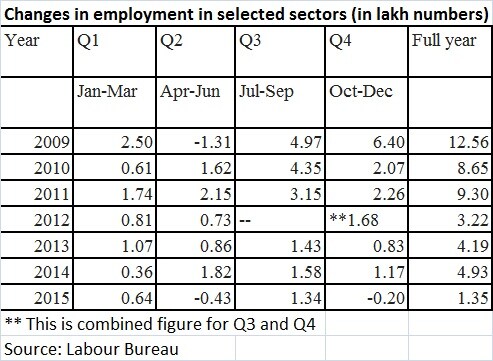New Delhi: About a million Indians reach the employment age every month. That is a daunting statistic, specially since job growth slowed to a six-year low in 2015 under the NDA government. The Indian economy continues to be one of the fastest growing in the world but this growth has obviously done little to fire up the job market. This is evident from the latest data released by the Labour Bureau through its quarterly survey of eight labour intensive sectors. The survey shows no new jobs were created but that there was actually a decline of 20,000 jobs across eight labour intensive sectors in the December quarter of 2015.  Remember, the September quarter of the same year had added 1.34 lakh new jobs across the same eight sectors and was still the slowest quarter in the previous six years (barring 2012 where quarter wise data was not available). Now, with the December quarter data in, total new jobs created across the eight sectors between January-December 2015 stood at just 1.35 lakh. This is the slowest pace of new jobs being created since 2009. Here’s some easy math for grasping the enormity of this slowdown in jobs under the NDA: The Modi government took charge in mid-2014 and for that full calendar year, 4.93 lakh jobs were added across these eight sectors. So job addition in the first full year of this government fell to just a fourth of 2014 and was only a tenth of the growth seen in 2009, when the UPA was in power. Rattled by these numbers, the Labour Bureau now wants to expand the scope of this quarterly survey besides also making it more current. This is a welcome move even if the motive is to show how most analysis of the existing data go against the government’s propaganda. In this story in the Economic Times today, a government official has been quoted saying the present system of quarterly surveys has not been able to capture the number of jobs created in the past two years “following the government’s enhanced focus on manufacturing and increase in non-agricultural activity in rural India.” The story also says that more than one crore people are added annually to India’s workforce, which stands at close to 50 crore. More than 93% of these workers are employed in the unorganised sector. D K Joshi, Chief Economist at Crisil, pointed out that India has no appropriate measurement of employment while welcoming this move to expand the scope and sample size of the quarterly survey. He said the country needs data not only on employment being generated in key sectors but also on parameters like labour intensive and non-intensive manufacturing industries, age group wise and also according to wages.  In January 2014, Joshi was one of the authors of a Crisil report on jobs which predicted a slowdown in employment generation in the coming years. The report had said “employment generation in the non-agriculture sector will slow down sharply in the coming years as the economy treads a lower-growth path. Crisil estimates that employment outside agriculture will increase by only 38 million between 2011-12 and 2018-19 compared with 52 million between 2004-05 and 2011-12. Due to insufficient employment creation in industry and services sectors, more workers will become locked in the least productive and low-wage agricultural sector. We estimate that 12 million people will join the agriculture workforce by 2018-19, compared with a decline of 37 million in agriculture employment between 2004-05 and 2011-12.” Madan Sabnavis, Chief Economist at Care Ratings, pointed out that job creation has been slow in the last few three years because of a virtual stagnation in manufacturing sector growth. “There has been limited job creation in the last couple of years despite India’s GDP showing an uptrend. This is because in the physical segment, we have not seen similar growth commensurately”. He pointed out that the government has really offered no new jobs in PSUs etc whereas even the private sector has seen layoffs or some replacement jobs at best these last few years. The Crisil report quoted earlier said slowing GDP growth is not the only culprit. The decline in employment creation has been compounded by falling labour intensity in the economy as automation rises. This is because the GDP growth in recent years has been driven by less labour-intensive services such as IT/ITeS, business and financial services and the capacity of labour intensive sectors such as manufacturing to absorb labour has diminished considerably in face of rising automation and complicated labour laws. Sectors such as IT/ITeS require only around 1-2 people to produce Rs 1 million of real value-added GDP so that higher growth in these sectors does not create large-scale employment. Also, the labour dependency of the manufacturing sector - which once used to be the most labour-intensive sector barring agriculture - has diminished considerably as automation has increased. So in this scenario, the government’s endeavour to widen its survey’s scope and include sector such as construction, metals, retail and hospitality should generate healthier results from the quarterly survey July onwards. But this would only be a small step in plugging the gaping data hole that the country now operates in vis-a-vis jobs. We need a much more comprehensive jobs’ data bank, on a quarterly and annual basis instead of having to rely on NSSO figures which come with considerable lag. As I have said in this piece Niti Ayog vice-chairman, Arvind Panagariya, has already pointed towards a fabulous opportunity for job creation if we are able to exploit the slowdown in China. Wages in that country remain abnormally high and labour is becoming increasingly scarce. Ideally, Chinese industry should be looking towards cost effective Indian manufacturing with abundant and cheap labour to get its mojo back. Panagariya admitted that job creation remains one of the biggest challenges for the NDA government and mentioned specific industries like clothing and footwear which are looking to set up manufacturing plants outside China because of labour issues. India needs a National Employment Policy, fewer labour laws which are easier to enforce and far better data capturing to figure out how much employment is being generated.
The story also says that more than one crore people are added annually to India’s workforce, which stands at close to 50 crore. More than 93% of these workers are employed in the unorganised sector
Advertisement
End of Article


)

)
)
)
)
)
)
)
)



